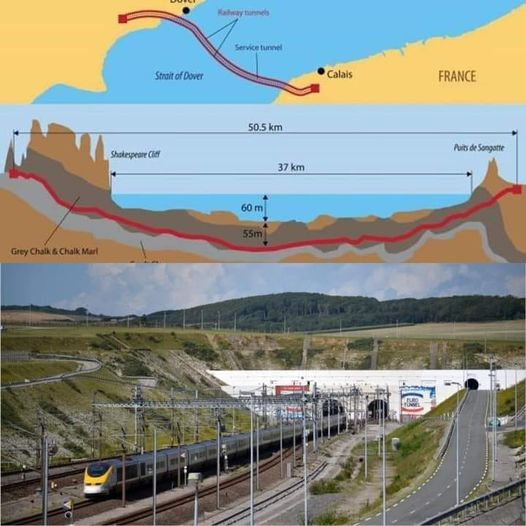
took 7 years, 4,000 workers and a secret weapon, geology, to complete the most daring engineering challenge of the 20th century. The Eurotunnel, or tunnel under the Channel, is 50.45 km long and connects Folkestone, England, to Coquelles, France – near Calais, in just 35 minutes of crossing. This is an incredible engineering feat characterized by the longest underwater tunnel in the world with an underwater section that stretches 39 km under the bed of the Channel.
The entire infrastructure consists of two railway tunnels of a diameter of 7.6 m and an emergency service tunnel of 4.8 m in diameter. It took 7 years, 4,000 workers and a secret weapon to build it: geology. Thanks to the geological study of the underground, it was possible to determine the trajectory of the excavation and the route that the Eurotunnel would follow. The technique of construction of the tunnel under the Channel. But how was the tunnel under the channel built? The big challenge was to understand how deep to position the tunnel and at what geological level to drill.
One of the key techniques was the so-called «seismic reflection,» a type of ground X-ray that allows you to visualize geological layers and whether they are wavy, distorted, or criss-crossed by gaps. Drilling machines called Tunnel Boring Machines (TBM) were used to perform drilling: these «mechanical moles» are 200 m long, have a 7.6 m diameter and a rotating disk with steel blades, and can dig 36 thousand tons of rock a day. TBM is controlled by a computerized system that calculates the trajectory with a laser.
As the cutter progresses, the TBM then creates a reinforced concrete coating ring for the tunnel, consisting of 5 curved segments called segments, which are used to withstand the intense pressure from the top. On December 1, 1990, the French and English teams met halfway, with a height difference of only 35 cm thanks to constant measures. The two completed tunnels are equipped with 245 steps to reach the rescue tunnel, fire doors and a very efficient cooling and ventilation system.
The only way to get through the tunnel is by train, like the high-speed train that takes you from Paris to London in just two hours, or the shuttle service for vehicles called «the Shuttle.» This train is very special because it takes all the vehicle you travel in to the end of transit, taking you from Calais to Folkestone in just 35 minutes. source: Geopop By Video StoryIt







Sé el primero en comentar